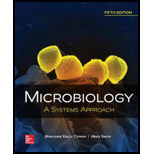
Concept explainers
(a)
To determine:
The similarities and dissimilarities between characteristics of hemorrhagic and non-hemorrhagic fever diseases.
Concept introduction:
Cardiovascular system also is known as circulatory system is a system which allows blood to flow throughout the body and transports nutrients, gases and other important enzymes in and out of the cells. It is composed of two components: Heart and the blood vessels. This system is highly protected from infections but microbes that successfully invade the system acquire entrance to many body parts affecting every system.
(b)
To provide:
The explanation for the observed increase in the incidence of these zoonotic infections around the world today.
Concept introduction:
Zoonoses are those animal diseases that are transmitted to humans. These diseases could be viral, bacterial fungal or
Want to see the full answer?
Check out a sample textbook solution
Chapter 20 Solutions
Microbiology: A Systems Approach
- A fever is considered to be a ____________________________. prognosis sign symptom syndromearrow_forwarda. Why do patients who survive tetanus and botulism often have no sequelae? b. How has modern medicine improved the survival rate for these two diseases?arrow_forwardDescribe the effects of Streptococcus pyogenes onconnective tissue in acute necrotizing fasciitis.arrow_forward
- A. What level of prevention is the administration of Sars Cov 2 Vaccine? B. What are its benefits to you as an individual and for the community.arrow_forwardExplain what features of the virulence, infectious dose, andincubation period of Ebola virus increase its transmission fromperson to person.arrow_forward#4arrow_forward
- a. Outline the unique characteristics of Mycobacterium.b. What is the epidemiology of TB?c. Differentiate between TB infection and TB disease.arrow_forwardList three local signs of infection and three systemic signs andexplain what is causing these signs.arrow_forwardDescribe about the treatment of fever.arrow_forward
- Briefly describe the long-Term Infections and their effects.arrow_forwardWrite the most likely causative microorganism and disease of the following cases and explain sign, symptoms and control measures. A 70-year-old woman presented after 3 days of enduring painful blisters only on the right side of her forehead and cheek and fever for the past 5 days. She developed the fluid-filled blisters 2 days after the fever. The pain was severe, continuous and radiating. She has medical history of chickenpox.arrow_forwardDescribe each type of infection in the following list and include the mode of transmission in each scenario. Use terms such as primary, secondary, healthcare-associated, STI, mixed, latent, toxemia, chronic, zoonotic, asymptomatic, local, and systemic to describe the types of infections (more than one term may apply, some may not apply to these conditions) 1) The development of Pneumocystisis pneumonia in an AIDS patientarrow_forward
- Essentials of Pharmacology for Health ProfessionsNursingISBN:9781305441620Author:WOODROWPublisher:CengageSurgical Tech For Surgical Tech Pos CareHealth & NutritionISBN:9781337648868Author:AssociationPublisher:Cengage
 Medical Terminology for Health Professions, Spira...Health & NutritionISBN:9781305634350Author:Ann Ehrlich, Carol L. Schroeder, Laura Ehrlich, Katrina A. SchroederPublisher:Cengage Learning
Medical Terminology for Health Professions, Spira...Health & NutritionISBN:9781305634350Author:Ann Ehrlich, Carol L. Schroeder, Laura Ehrlich, Katrina A. SchroederPublisher:Cengage Learning - Health Safety And Nutrition F/Young ChildHealth & NutritionISBN:9781305144767Author:MAROTZPublisher:Cengage



